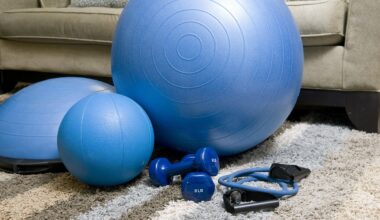How to Warm Up and Cool Down on a Treadmill
Warming up before exercising is essential for preparing your body for physical activity and preventing injuries. When using a treadmill, start with a gentle walk to gradually increase your heart rate. Walking for about 5 to 10 minutes at a slow, comfortable pace allows your muscles and joints to loosen up. Focus on maintaining good posture, with your shoulders back and head held high while your arms swing naturally. It’s important to wear proper footwear for adequate support. During your warm-up, you should incorporate dynamic stretches such as leg swings or arm circles to enhance blood flow and flexibility. While warming up, listen to your body and adjust your speed if needed. Striking a balance between preparing your body for more intense exercise and avoiding overstretching is pivotal. After the warm-up, you can gradually increase the intensity of your workout. Always consult with fitness professionals if unsure about proper warm-up techniques. Incorporating this routine will not only enhance your workout performance but also contribute to long-term fitness goals.
Cooling down post-exercise is as crucial as warming up. After your treadmill workout, shift from a high-intensity pace to a slower walk to help your body transition. Aim for a 5 to 10 minute cooldown, which can lower your heart rate gradually and reduce muscle stiffness. It also promotes recovery and decreases the risk of soreness following a workout. As you cool down, take deep breaths to facilitate oxygen exchange and relaxation of your body. Incorporating static stretches at this time can also help. Focus on stretching the major muscle groups that were engaged during your run—particularly your calves, hamstrings, and quadriceps. Hold each stretch for 15 to 30 seconds, ensuring you don’t bounce, as this could lead to injury. Consider using a towel or mat for extra support during your stretches. Hydration is equally important during the cooldown phase. Drink water to replenish fluids lost during exercise. Cooling down not only assists in muscle recovery but also helps you mentally conclude your exercise session, providing a sense of accomplishment.
Benefits of a Proper Warm-Up
A proper warm-up has several advantages that can significantly impact your gym experiences. First and foremost, it prepares your cardiovascular system for the upcoming physical exertion. By gradually increasing your heart rate and blood flow to muscles, you create a safer environment for intense workouts. Additionally, warming up helps to reduce the risk of strains and injuries. This is especially important for first-time treadmill users or those returning after a break. Incorporating mobility exercises into your warm-up routine may also improve your range of motion and performance. Secondly, a warm-up can positively affect your mental state. It allows you to mentally shift focus from daily distractions onto your upcoming workout. Preparing mentally is crucial for achieving better results and enhancing your overall performance. Also, engaging in warm-up activities can stimulate endorphin production, leading to an enhanced sense of well-being. You will likely find yourself more energized and motivated once you complete your warm-up. Making it a habit to warm up before each workout may increase overall effectiveness, resulting in improved fitness outcomes over time.
The Importance of Hydration
Hydration plays an essential role in both warm-up and cooldown routines when using a treadmill. Before starting your exercise, it’s important to drink water to ensure your body is adequately hydrated. This helps maintain your performance levels and keeps your joints lubricated. Dehydration can lead to fatigue, decreased motivation, and even dizziness during workouts. Be sure to carry a water bottle to keep yourself refreshed throughout your exercise. Sipping small amounts of water every 10 to 15 minutes will encourage consistent hydration without overloading your stomach. After finishing your treadmill session, replenishing lost fluids is particularly important since sweat loss can significantly impact performance and recovery. It’s also beneficial to include electrolytes to restore balance, especially after intense workouts. Utilizing electrolyte-rich drinks or sports beverages can help maintain fluid balance and energy levels. Timing is everything; ensure you’re hydrating not just post-workout, but throughout your entire exercise routine. A well-hydrated body performs at its highest potential, further enhancing the benefits of your warm-up and cooldown efforts. Therefore, always prioritize hydration for optimum performance.
Warming up also enhances muscle elasticity, improving your overall flexibility, contributing significantly to performance results. Muscle elasticity plays a vital role in how effectively you can move, particularly on equipment such as treadmills. As muscles warm up, they become more pliable, allowing for better strides and reduced risk of injury. To maximize this benefit, focus on targeted dynamic stretches specific to running. These may include lunges, leg swings, or high knees, which are particularly effective for engaging your key muscle groups. Additionally, practicing a proper warm-up routine establishes a psychological advantage. Knowing that you’ve prepared properly can give you increased confidence in your performance. Establishing this routine also helps signal to your body and mind that it’s time to exercise. You may find that developing a consistent pre-workout regimen not only fosters better physical results but also cultivates discipline in your fitness journey. Therefore, prioritize a robust warm-up routine featuring both cardiovascular and flexibility-enhancing exercises. You are likely to notice marked improvements in endurance, speed, and overall workout satisfaction, ultimately optimizing your treadmill experience.
Effective Cool Down Techniques
Implementing effective cooldown techniques is essential for maximizing recovery and benefits post-exercise. Begin by gradually reducing your treadmill speed. Instead of abruptly stopping, decrease your pace over several minutes until you reach a gentle walk. This allows your heart rate and breathing to stabilize. Following this, engaging in stretching exercises is vital; consider incorporating full-body stretches to target key muscle groups heavily utilized during your workout. Stretching prevents stiffness and keeps your muscle lengthening optimal. Take time to stretch out your hamstrings, calves, glutes, and even your back. Important to note is that maintaining proper technique during cooldown stretches will enhance your recovery further. While stretching, hold each position for roughly 15-30 seconds and breathe deeply to get the full benefits. Incorporating foam rolling into your cooldown can also be effective in releasing tension in tight muscles. You may consider investing in a foam roller for at-home sessions. Furthermore, practicing mindfulness during your cooldown, by focusing on deep breathing and relaxation, assists in mental recovery also. Thus, combining physical and mental cooldown techniques promotes overall wellness following your treadmill workouts.
Lastly, always remember that both warm-up and cooldown are integral components of any treadmill workout routine. Neglecting these aspects could undermine your fitness efforts and even lead to long-term injuries. Taking the time to adequately prepare your body before intense sessions ensures that you’re able to perform safely and effectively. Additionally, incorporating cooldown exercises into your routine fosters muscle recovery, enhancing your training’s overall efficacy. By developing strong habits around warm-up and cooldown practices, you’re building a solid foundation for continued fitness growth. Consider tracking your routines to identify what works best for you and optimize your training. Elevating the importance of these components may not only improve physical well-being but also enrich the psychological aspects of working out. The commitment to these stages of your exercise ensures continued progress on your fitness journey while lowering potential setbacks due to muscle injury or excessive fatigue. Subsequently, embracing these principles will yield positive outcomes in your treadmill workout experience, leading to better performance and sustainable health long-term.


